


This article was published on my Patreon page in January 2023—with slight modifications in the text here. Since the series is going to the start of Bob Clampett’s directorial career, and for readers to keep abreast of the important details, here’s a link that presents the animator breakdown columns of Clampett’s first season of B&W Looney Tunes in production order. (Animator breakdown columns detailing Porky’s Poppa and Porky’s Five & Ten will follow within the next few weeks.)
LT-3: Porky’s Badtime Story
LT-4: Get Rich Quick Porky
LT-5: Rover’s Rival
LT-6: Porky’s Hero Agency
LT-7: Porky’s Poppa
LT-8: What Price Porky
LT-9: Porky’s Five & Ten
LT-10: Injun Trouble (also includes its 1945 remake, Wagon Heels)
LT-11: Porky’s Party
LT-12: Porky & Daffy
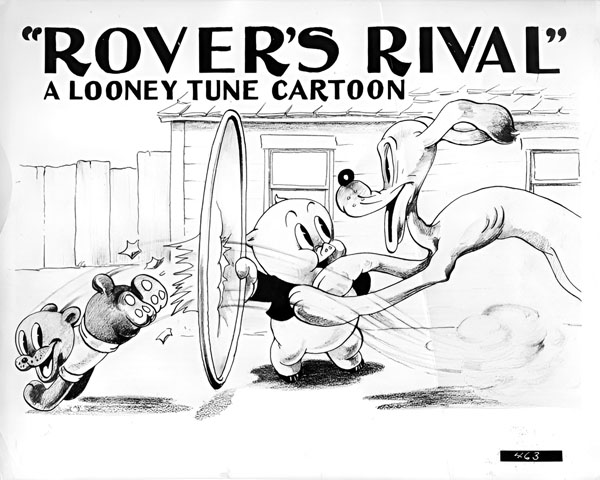
In May 1937, Leo McCarey’s moving drama Make Way for Tomorrow premiered in New York. In McCarey’s film, an elderly couple (played by Victor Moore and Beulah Bondi) has their home foreclosed, forcing them to separate and live with two different children. A month later, on June 14th, animation began on Clampett’s third Looney Tune with Porky and his octogenarian hound, Rover. Both films share a similar theme of the elderly and their undignified treatment by a younger generation. Make Way for Tomorrow didn’t reach Los Angeles theaters until the following July, a month after Rover started animation. Clampett likely was aware of McCarey’s film (which the National Film Board put in its Top 10 for the year) and took inspiration from its emotional contour.
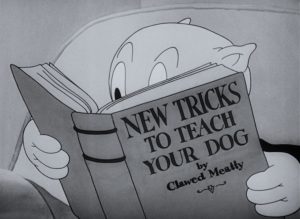
Porky reads a dog training book by “Clawed Meaty,” a spoof of the world-renowned animal trainer, zoo owner, and circus mogul Clyde Beatty (1903-1965).
The working title for Rover, listed on the production draft, was “Ol’ Man Rover,” a play on “Old Man River,” a song introduced in the 1927 musical Show Boat and performed by several recording artists in the 1930s. On the back of the production sheet, Clampett scribbled a placeholder title, “Porky’s Bag o’ Tricks!” The draft lists “Bob + Chuck” in the top margins, where a director’s name was usually marked, which implies that Clampett and Jones directed Rover’s Rival as a team, as discussed in the “redux” post for Get Rich Quick Porky. Like Get Rich and subsequent Looney Tunes directed by Clampett, Jones is only credited as an animator in the main titles. Jones is not given long sequences, as in Porky’s Badtime Story or Get Rich, which might account for his function as a co-director.
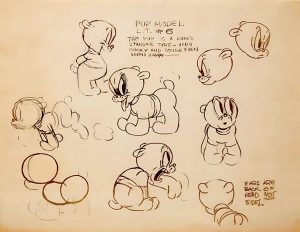 Regarding the voices of the two canine co-stars, voice actor-historian Keith Scott surmises that Rover’s vocals belong to the same older actor used by Tex Avery in Ain’t We Got Fun, released in May 1937, shortly before Rover went into animation. As for “Zippy,” his voice actor was that of the little gabby duck in Friz Freleng’s She Was an Acrobat’s Daughter, released in March 1937. Without proper documentation, Keith’s research has yielded no conclusive results as of this writing. What is known is that, besides voicing Porky, Mel Blanc recorded the seal barks when Zippy imitates a seal and the line when he mimics Porky.
Regarding the voices of the two canine co-stars, voice actor-historian Keith Scott surmises that Rover’s vocals belong to the same older actor used by Tex Avery in Ain’t We Got Fun, released in May 1937, shortly before Rover went into animation. As for “Zippy,” his voice actor was that of the little gabby duck in Friz Freleng’s She Was an Acrobat’s Daughter, released in March 1937. Without proper documentation, Keith’s research has yielded no conclusive results as of this writing. What is known is that, besides voicing Porky, Mel Blanc recorded the seal barks when Zippy imitates a seal and the line when he mimics Porky.
Clampett handed Norm McCabe substantial character business in Rover—an increase from Get Rich Quick Porky. McCabe animated Rover’s second attempt at fetching a stick when he leaves his dentures behind. Not realizing the stick had been swiped by Zippy, the toothless Rover opens his mouth; McCabe, perhaps under Clampett’s suggestion, added saliva to emphasize the gag. Bobe Cannon, who further developed his animation skills with each cartoon for the Katz unit, was entrusted with the tender coda of the cartoon: Zippy apologizes to Rover for his awful behavior when he fears the old dog has succumbed to a dynamite blast. (The closing line spoken by Rover after he quickly recovers, “Do ya mean it?” was the memorable tagline from Bert Gordon’s Mad Russian character, frequently heard on Eddie Cantor’s Texaco Town radio program.)
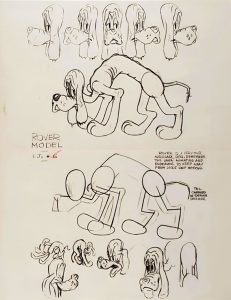 In sync with the subject matter of Rover’s Rival, Carl Stalling’s musical score incorporates songs about man’s relationship with dogs and canine activity. The traditional folk tune, “Bulldog on the Bank,” plays underneath the opening titles of Rover in a lively swing arrangement. Porky’s first scenes, as he examines the educational book on dog tricks to teach “Ol’ Strongheart,” utilize Webb M. Oungst and Cy Perkins’ 1912 tune, “They Gotta Quit Kickin’ My Dog Around”; Stalling cues the song in brief snatches throughout the film. When the decrepit Rover wobbles over to his master, in superb animation by Chuck Jones, the score switches to Stephen Foster’s “Old Black Joe.” Another Stephen Foster song, “Old Dog Tray,” plays as a recurring theme for Rover; the obligatory usage of Septimus Winner’s “Oh Where, oh Where Ish Mine Little Dog Gone” (or “Der Deitcher’s Dog”) is used to emphasize Zippy’s antagonistic presence.
In sync with the subject matter of Rover’s Rival, Carl Stalling’s musical score incorporates songs about man’s relationship with dogs and canine activity. The traditional folk tune, “Bulldog on the Bank,” plays underneath the opening titles of Rover in a lively swing arrangement. Porky’s first scenes, as he examines the educational book on dog tricks to teach “Ol’ Strongheart,” utilize Webb M. Oungst and Cy Perkins’ 1912 tune, “They Gotta Quit Kickin’ My Dog Around”; Stalling cues the song in brief snatches throughout the film. When the decrepit Rover wobbles over to his master, in superb animation by Chuck Jones, the score switches to Stephen Foster’s “Old Black Joe.” Another Stephen Foster song, “Old Dog Tray,” plays as a recurring theme for Rover; the obligatory usage of Septimus Winner’s “Oh Where, oh Where Ish Mine Little Dog Gone” (or “Der Deitcher’s Dog”) is used to emphasize Zippy’s antagonistic presence.
For the scenes of Rover and Zippy’s competition with dog stunts, Stalling uses Al Dubin and Harry Warren’s “‘Cause My Baby Says It’s So,” from the 1937 Warner Bros. musical The Singing Marine. Another Dubin-Warren tune, “All’s Fair in Love and War,” from Gold Diggers of 1937, plays in a frenetic style when Porky retrieves sticks of dynamite from both dogs, and in the following scenes when Rover scrambles into the house to look up “dynamite” in the dictionary. (John Carey animated Rover’s close-ups, beautifully rendered with detailed shadows.) Mort Dixon and Harry Warren’s 1928 Tin Pan Alley hit, “Nagasaki,” complements Zippy’s relentless torment of Porky with a proliferation of lit dynamite sticks, as animated by Chuck Jones. “Nagasaki” became a favorite of Stalling’s and was used frequently in his cartoon scores.
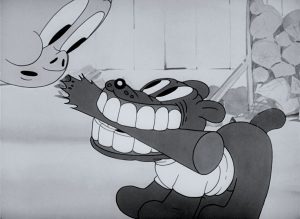 A closer analysis of the production papers reveals a few feet of animation omitted from the final picture. In scene 6, after Rover lifts his ear and responds to Porky’s command to roll over, scene 7 proceeds in mid-action: Porky emits sweat droplets as Rover prepares to roll over, which lasts only a second of screen time. The production draft shows that scene 7 involved Porky yelling his command for Rover since his elderly dog is hard of hearing; it was initially a 12-foot scene or eight seconds of footage. Additionally, in scene 9, credited to Jerry Hathcock, an audio gaffe occurs when Porky speaks dialogue to Rover, but Mel Blanc’s vocals are absent.
A closer analysis of the production papers reveals a few feet of animation omitted from the final picture. In scene 6, after Rover lifts his ear and responds to Porky’s command to roll over, scene 7 proceeds in mid-action: Porky emits sweat droplets as Rover prepares to roll over, which lasts only a second of screen time. The production draft shows that scene 7 involved Porky yelling his command for Rover since his elderly dog is hard of hearing; it was initially a 12-foot scene or eight seconds of footage. Additionally, in scene 9, credited to Jerry Hathcock, an audio gaffe occurs when Porky speaks dialogue to Rover, but Mel Blanc’s vocals are absent.
Due to a tear in the aged paper, scenes 20 and 21 have missing animator assignments in the production draft. Bobe Cannon animated scene 19 of Rover and Zippy and scene 22 of Porky, so it’s safe to assume that Cannon also animated scene 20 since the drawing of Porky looks similar when the action cuts back to scene 22. However, the probable animator in scene 21 of Zippy mimicking Porky might be Chuck Jones, based on the spacing and movement in shots attributed to him throughout the cartoon.
Rover’s Rival had a New York debut in Broadway’s Strand Theater on October 2, 1937; its nationwide release occurred on October 9. The cartoon is noteworthy for two primary reasons: the first usage of Dave Franklin and Cliff Friend’s “The Merry-Go-Round Broke Down” as the theme music for the Looney Tunes in the opening and closing titles, and Porky’s signature curtain call, when he tears through a drumhead and signs off directly to the audience, “Th-th-that’s all, folks!”


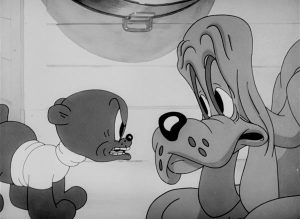
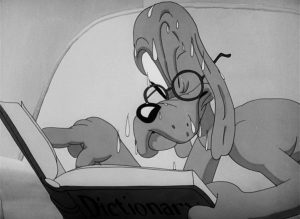
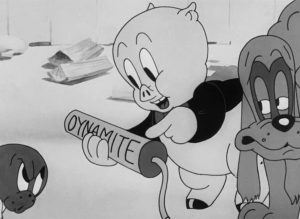
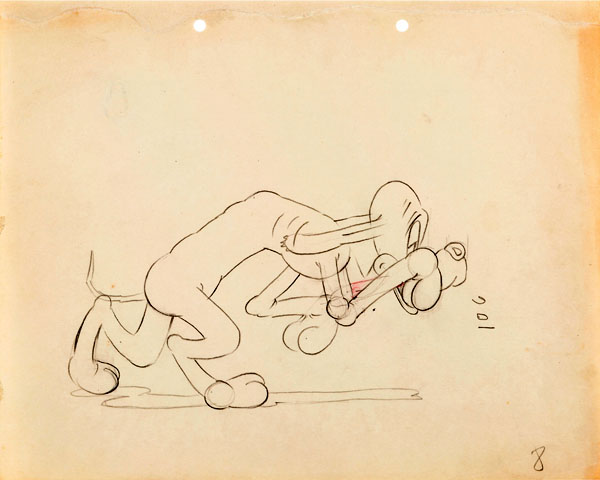
Thanks to Jerry Beck, Ruth Clampett, Mark Kausler, Keith Scott, and Frank M. Young for this post’s information and production materials.